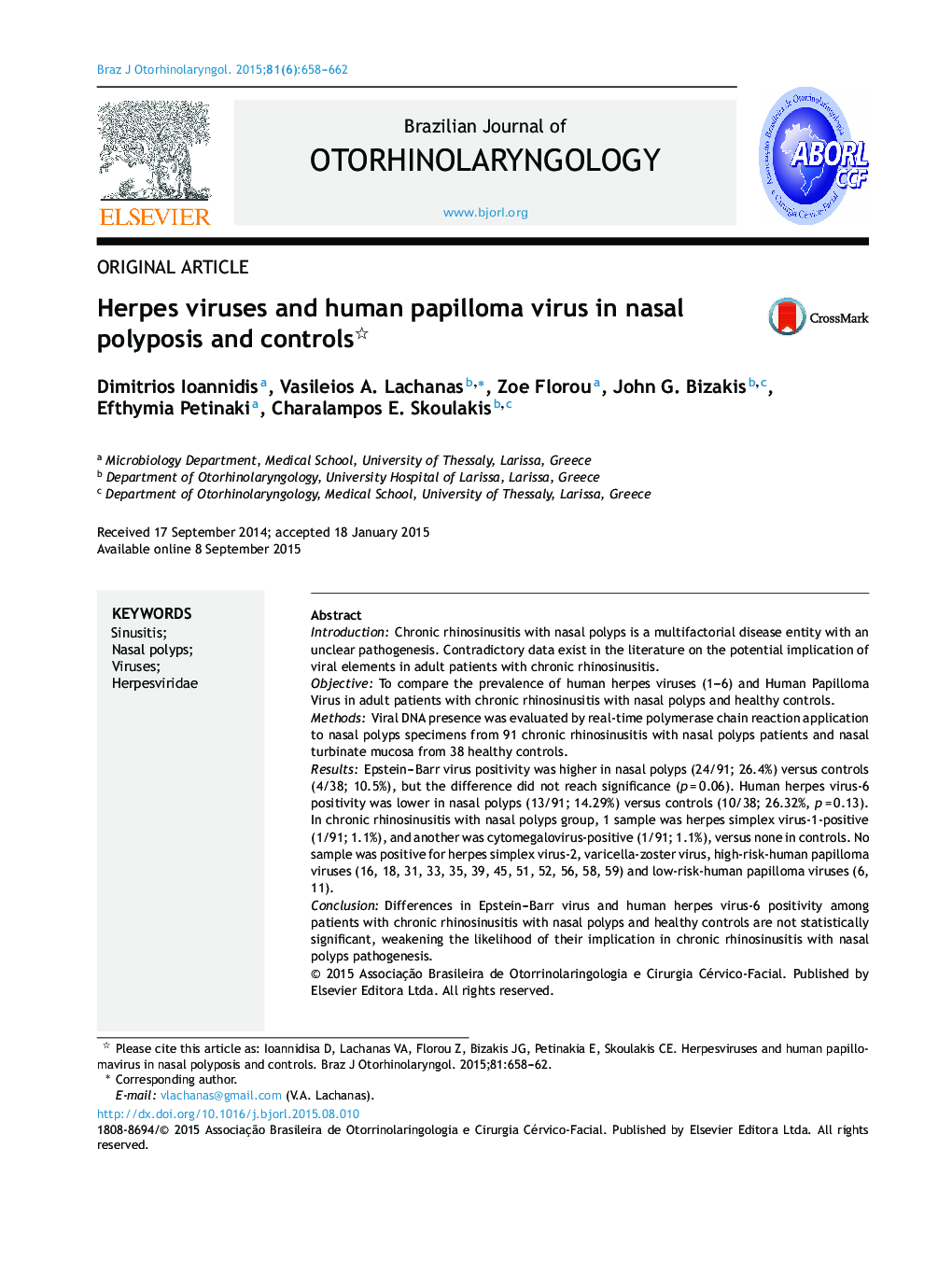| کد مقاله | کد نشریه | سال انتشار | مقاله انگلیسی | نسخه تمام متن |
|---|---|---|---|---|
| 4106265 | 1605364 | 2015 | 5 صفحه PDF | دانلود رایگان |
IntroductionChronic rhinosinusitis with nasal polyps is a multifactorial disease entity with an unclear pathogenesis. Contradictory data exist in the literature on the potential implication of viral elements in adult patients with chronic rhinosinusitis.ObjectiveTo compare the prevalence of human herpes viruses (1–6) and Human Papilloma Virus in adult patients with chronic rhinosinusitis with nasal polyps and healthy controls.MethodsViral DNA presence was evaluated by real-time polymerase chain reaction application to nasal polyps specimens from 91 chronic rhinosinusitis with nasal polyps patients and nasal turbinate mucosa from 38 healthy controls.ResultsEpstein–Barr virus positivity was higher in nasal polyps (24/91; 26.4%) versus controls (4/38; 10.5%), but the difference did not reach significance (p = 0.06). Human herpes virus-6 positivity was lower in nasal polyps (13/91; 14.29%) versus controls (10/38; 26.32%, p = 0.13). In chronic rhinosinusitis with nasal polyps group, 1 sample was herpes simplex virus-1-positive (1/91; 1.1%), and another was cytomegalovirus-positive (1/91; 1.1%), versus none in controls. No sample was positive for herpes simplex virus-2, varicella-zoster virus, high-risk-human papilloma viruses (16, 18, 31, 33, 35, 39, 45, 51, 52, 56, 58, 59) and low-risk-human papilloma viruses (6, 11).ConclusionDifferences in Epstein–Barr virus and human herpes virus-6 positivity among patients with chronic rhinosinusitis with nasal polyps and healthy controls are not statistically significant, weakening the likelihood of their implication in chronic rhinosinusitis with nasal polyps pathogenesis.
ResumoIntroduçãoA rinossinusite crônica com pólipos é uma doença multifatorial de etiopatogênese ainda não definida. Existem dados contraditórios na literatura sobre a implicação potencial de elementos virais na etiologia de pólipos nasossinusais.ObjetivoComparar a prevalência de herpes vírus humanos (1–6) e papiloma vírus humano em pacientes adultos com rinossinusite crônica com pólipos nasais (CRwNP) e controles saudáveis.MétodoA presença de DNA viral foi avaliada por PCR em tempo real, em amostras de pólipos nasais de 91 pacientes com CRwNP e na mucosa das conchas nasais de 38 controles saudáveis.ResultadosA positividade do EBV foi maior nos pólipos nasais (24/91; 26,4%) do que nos controles (4/38; 10,5%), mas a diferença não foi significante (p = 0,06). O HHV-6 apresentou positividade menor nos pólipos nasais (13/91; 14,29%) do que os controles (10/38; 26,32%), (p = 0,13). No grupo CRwNP, uma amostra foi positiva para o vírus herpes simples (HSV-1) (1/91; 1,1%), e uma para citomegalovírus (CMV) (1/91; 1,1%); e nenhuma amostra foi positiva no grupo controle. Não houve amostra positiva para HSV-2, VZV, HR-HPV (16,18, 31, 33, 35, 39, 45, 51, 52, 56, 58, 59) e LR-HPV (6,11).ConclusãoDiferenças de positividade do EBV e HHV-6 entre pacientes com CRwNP e controles saudáveis não são estatisticamente significantes, enfraquecendo a probabilidade de sua implicação na patogênese da CRwNP.
Journal: Brazilian Journal of Otorhinolaryngology - Volume 81, Issue 6, November–December 2015, Pages 658–662
